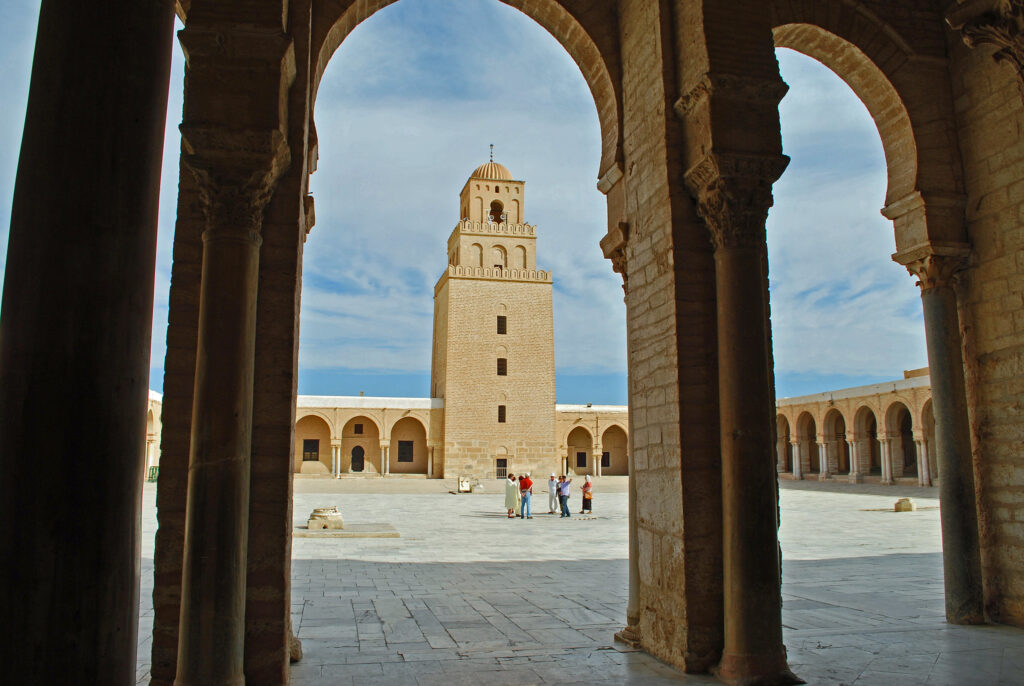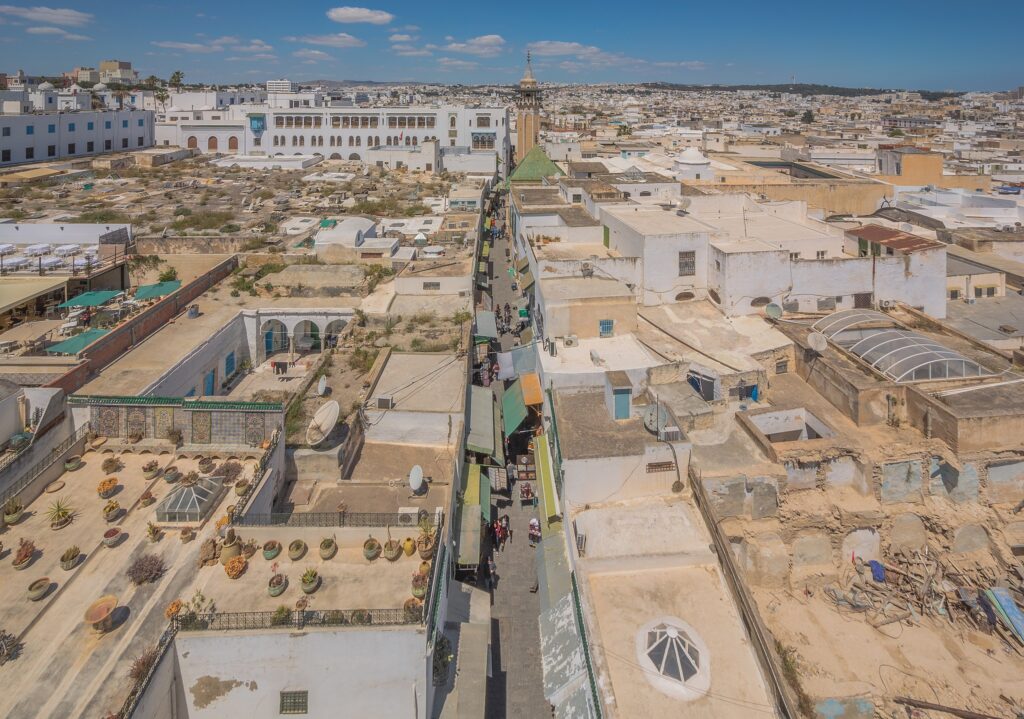Quick facts about Tunisia:
- Population: Approximately 12 million people.
- Capital: Tunis.
- Largest City: Tunis.
- Official Language: Arabic.
- Other Languages: French is also widely spoken.
- Currency: Tunisian Dinar (TND).
- Government: Unitary semi-presidential republic.
- Major Religion: Islam, predominantly Sunni.
- Geography: Located in North Africa, bordered by Algeria to the west and southwest, Libya to the southeast, and the Mediterranean Sea to the north and east.
Fact 1: Tunisia is the northernmost country in Africa
Its northernmost point, Cape Angela, juts into the Mediterranean Sea, making Tunisia a key gateway between Africa and Europe. This strategic location has historically contributed to Tunisia’s rich cultural exchanges, trade, and influence from various civilizations, including the Phoenicians, Romans, and Arabs. The country’s Mediterranean climate and coastal scenery also enhance its appeal as a tourist destination, drawing visitors to its historic cities, beaches, and archaeological sites.

Fact 2: Tunisia started the Arab Spring
Tunisia is famously known for sparking the Arab Spring, a wave of protests and political upheaval that began in late 2010. The movement started when Mohamed Bouazizi, a young street vendor, self-immolated in protest of police corruption and ill-treatment. His act of defiance ignited widespread demonstrations across Tunisia, ultimately leading to the ousting of President Zine El Abidine Ben Ali, who had ruled for 23 years.
The success of the Tunisian protests inspired similar movements in other Arab countries, including Egypt, Libya, Syria, and Yemen, where people took to the streets demanding political reform, economic opportunities, and greater freedoms. These protests resulted in the overthrow of several long-standing regimes and sparked significant political and social changes across the region, although the outcomes varied widely from country to country.
Fact 3: Tunisia was the capital of ancient Carthage
Tunisia was home to the ancient city of Carthage, which served as the capital of the powerful Carthaginian Empire and a formidable rival to Rome. Founded by Phoenician settlers in the 9th century BCE, Carthage became a major center of trade and military power in the Mediterranean.
The city is perhaps best known for its conflicts with Rome, particularly the Punic Wars, which spanned from 264 BCE to 146 BCE. These wars were marked by legendary military leaders, such as Hannibal, who famously crossed the Alps with his army to challenge Rome.
Despite its strength and resilience, Carthage ultimately fell to Rome in 146 BCE after the Third Punic War. The Romans destroyed the city, and it was later rebuilt as a Roman colony, becoming one of the most important cities in the Roman Empire.

Fact 4: In Tunisia, the water supply system was well developed
Carthage, and later Roman cities in the region, featured advanced engineering marvels that efficiently managed water resources to support urban populations and agriculture.
One of the most notable examples is the Zaghouan Aqueduct, which was constructed in the 2nd century CE to supply water to Carthage from the Zaghouan mountain springs, over 130 kilometers away. This impressive feat of engineering included aqueduct bridges, tunnels, and reservoirs, showcasing the Romans’ mastery in hydraulic engineering.
These systems ensured a reliable supply of fresh water for drinking, bathing, irrigation, and public baths, contributing significantly to the prosperity and daily life of the inhabitants. The remains of these aqueducts and water supply infrastructures are a testament to the ingenuity and technical skills of ancient engineers in Tunisia.
Fact 5: Kairouan is an important city for Muslims
Founded in 670 CE by the Arab general Uqba ibn Nafi, Kairouan quickly became a center of Islamic learning and culture in North Africa. It is considered the fourth holiest city in Islam, following Mecca, Medina, and Jerusalem.
The city’s most iconic landmark is the Great Mosque of Kairouan, also known as the Mosque of Uqba. This historic mosque, with its massive prayer hall, towering minaret, and expansive courtyard, is one of the oldest and most important mosques in the Muslim world. It has served as a model for other mosques throughout the region and remains a key site of pilgrimage and religious study.
Kairouan’s significance extends beyond its religious heritage. It was a major center of trade, scholarship, and craftsmanship, particularly noted for its production of exquisite carpets and textiles. The city’s rich history and cultural contributions have earned it a place on the UNESCO World Heritage list.

Fact 6: Couscous is the most popular dish
This versatile dish, made from steamed semolina wheat granules, is typically served with a rich stew that includes meat (such as lamb, chicken, or fish), vegetables, and a blend of aromatic spices. Couscous holds a central place in Tunisian cuisine, often featured in family gatherings, celebrations, and special occasions.
During the winter months, Tunisians enjoy a special dish called “lablabi.” This hearty and warming dish is a chickpea soup flavored with garlic, cumin, and harissa (a spicy chili paste). Lablabi is traditionally served with chunks of day-old bread soaked in the broth, and it is often topped with a poached egg, olives, capers, and a drizzle of olive oil. The dish is particularly popular during the colder season as it provides both warmth and nourishment.
Fact 7: Tunisia has good and popular beaches with tourists
Tunisia is renowned for its beautiful and popular beaches, which attract tourists from around the world. The country’s Mediterranean coastline stretches for over 1,300 kilometers, offering a variety of stunning beaches that cater to different tastes and preferences.
- Hammamet: Known for its golden sandy beaches and clear blue waters, Hammamet is one of Tunisia’s most famous resort towns. It offers a mix of vibrant nightlife, luxury resorts, and historical sites, making it a favorite destination for both relaxation and exploration.
- Sousse: Often referred to as the “Pearl of the Sahel,” Sousse boasts beautiful beaches lined with palm trees and a lively atmosphere. The city is also home to a UNESCO-listed medina, adding cultural richness to the beach experience.
- Djerba: This island in the south of Tunisia is known for its picturesque beaches, calm waters, and charming traditional villages. Djerba is popular among tourists seeking a more serene and laid-back environment.
- Monastir: With its pristine beaches and historical significance, Monastir is a popular tourist spot. The city combines beautiful coastal views with attractions like the Ribat of Monastir, an ancient Islamic fortress.
- Mahdia: Known for its less crowded and more tranquil beaches, Mahdia offers a peaceful retreat with its fine white sands and turquoise waters. It is an ideal spot for those looking to escape the hustle and bustle.
- Nabeul: Located near Hammamet, Nabeul is famous for its long stretches of sandy beaches and vibrant local markets. It’s a great destination for enjoying the beach and experiencing local crafts and pottery.

Fact 8: To preserve nature, 17 national parks have been established in Tunisia
To preserve its rich natural heritage, Tunisia has established 17 national parks, each offering unique landscapes and diverse wildlife. Here are a few of the most popular:
Ichkeul National Park: A UNESCO World Heritage site, Ichkeul National Park is centered around Lake Ichkeul and is a critical stopover for migratory birds. It hosts thousands of species, including flamingos and storks, making it a paradise for bird watchers and nature enthusiasts.
Jebil National Park: Situated in the Sahara Desert, Jebil National Park features vast sand dunes and arid landscapes. It provides a habitat for desert-adapted species such as the Dorcas gazelle and the Fennec fox, offering visitors a glimpse into the unique flora and fauna of the Sahara.
Bouhedma National Park: Located in central Tunisia, this park protects steppe and forest ecosystems. It is home to rare species like the addax antelope and the Barbary sheep, making it an important site for wildlife conservation.
Zembra and Zembretta National Park: Comprising two islands in the Mediterranean Sea, this marine park is renowned for its seabird colonies and underwater biodiversity. It attracts divers and nature lovers interested in exploring its rich marine life.
Note: If you are planning a trip, check if you need an International Driver’s License in Tunisia to rent and drive a car.
Fact 9: The Medina quarter in Tunisia is famous for its concentration of monuments
The Medina quarter in Tunis is renowned for its rich concentration of historical monuments and cultural heritage. The Medina of Tunis, a UNESCO World Heritage site, is a labyrinthine district filled with over 700 historic monuments, including palaces, mosques, mausoleums, and madrasas. Notable landmarks include the Zaytouna Mosque, one of the oldest and most significant mosques in the Muslim world, and the Dar Hussein Palace, which exemplifies traditional Tunisian architecture.

Fact 10: The largest Roman amphitheater is located in Tunisia
El Djem is home to the impressive Amphitheatre of El Jem, also known as the Thysdrus Amphitheatre, which is one of the best-preserved Roman amphitheaters in the world.
Built around the 3rd century CE, during the Roman Empire’s heyday in North Africa, the Amphitheatre of El Jem was capable of seating up to 35,000 spectators. It was primarily used for gladiatorial contests and other public spectacles, reflecting the grandeur and entertainment culture of Roman society.
The amphitheater’s massive structure, with its towering walls and intricate arches, is a testament to Roman engineering prowess. It is often compared to the Colosseum in Rome for its size and architectural significance. In 1979, the Amphitheatre of El Jem was designated as a UNESCO World Heritage site, recognizing its cultural and historical importance.

Published June 29, 2024 • 8m to read





